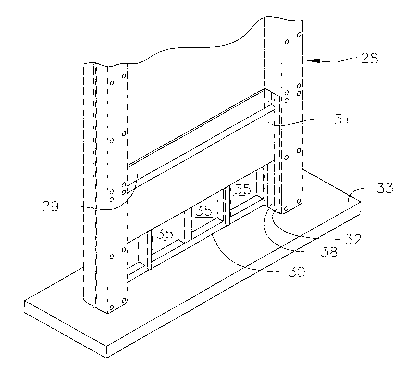Some of the information on this Web page has been provided by external sources. The Government of Canada is not responsible for the accuracy, reliability or currency of the information supplied by external sources. Users wishing to rely upon this information should consult directly with the source of the information. Content provided by external sources is not subject to official languages, privacy and accessibility requirements.
Any discrepancies in the text and image of the Claims and Abstract are due to differing posting times. Text of the Claims and Abstract are posted:
| (12) Patent Application: | (11) CA 2624320 |
|---|---|
| (54) English Title: | TRANSFORMER FIREWALL WITH COOLING VENT |
| (54) French Title: | CLOISON PARE-FEU DE TRANSFORMATEUR AVEC OUIES DE REFROIDISSEMENT |
| Status: | Deemed Abandoned and Beyond the Period of Reinstatement - Pending Response to Notice of Disregarded Communication |
| (51) International Patent Classification (IPC): |
|
|---|---|
| (72) Inventors : |
|
| (73) Owners : |
|
| (71) Applicants : |
|
| (74) Agent: | OYEN WIGGS GREEN & MUTALA LLP |
| (74) Associate agent: | |
| (45) Issued: | |
| (86) PCT Filing Date: | 2006-10-10 |
| (87) Open to Public Inspection: | 2007-04-19 |
| Examination requested: | 2008-04-01 |
| Availability of licence: | N/A |
| Dedicated to the Public: | N/A |
| (25) Language of filing: | English |
| Patent Cooperation Treaty (PCT): | Yes |
|---|---|
| (86) PCT Filing Number: | PCT/US2006/039413 |
| (87) International Publication Number: | WO 2007044676 |
| (85) National Entry: | 2008-04-01 |
| (30) Application Priority Data: | ||||||
|---|---|---|---|---|---|---|
|
A highly protective vented firewall (28) is supported between upstanding
columns or beams (15). The firewall is made of an inorganic cementitious
material which is preferably inorganic phosphate cement. Vent openings (35)
are provided to enable flow of cooling air through the firewall during normal
operating conditions. A heat-activatable means (35) automatically closes the
vents should a fire occur.
cette invention concerne une cloison pare-feu ventilée haute sécurité (28) maintenue entre des colonnes ou des montants verticaux (15). La cloison pare-feu est faite d'un matériau à base de ciment inorganique, de préférence un ciment de phosphate inorganique. Des ouïes (35) laissent passer l'air à travers la cloison pare-feu en conditions normales de fonctionnement. En cas d'incendie, un dispositif à commande thermo-actionnable (35) ferme automatiquement les ouïes.
Note: Claims are shown in the official language in which they were submitted.
Note: Descriptions are shown in the official language in which they were submitted.

2024-08-01:As part of the Next Generation Patents (NGP) transition, the Canadian Patents Database (CPD) now contains a more detailed Event History, which replicates the Event Log of our new back-office solution.
Please note that "Inactive:" events refers to events no longer in use in our new back-office solution.
For a clearer understanding of the status of the application/patent presented on this page, the site Disclaimer , as well as the definitions for Patent , Event History , Maintenance Fee and Payment History should be consulted.
| Description | Date |
|---|---|
| Time Limit for Reversal Expired | 2010-10-12 |
| Application Not Reinstated by Deadline | 2010-10-12 |
| Deemed Abandoned - Failure to Respond to Maintenance Fee Notice | 2009-10-13 |
| Inactive: Office letter | 2009-03-24 |
| Letter Sent | 2009-03-24 |
| Inactive: IPC assigned | 2008-10-16 |
| Inactive: Correspondence - Transfer | 2008-10-16 |
| Inactive: First IPC assigned | 2008-10-15 |
| Inactive: Office letter | 2008-09-23 |
| Amendment Received - Voluntary Amendment | 2008-08-07 |
| Inactive: Cover page published | 2008-07-16 |
| Inactive: Declaration of entitlement/transfer requested - Formalities | 2008-07-08 |
| Inactive: Acknowledgment of national entry - RFE | 2008-07-02 |
| Letter Sent | 2008-07-02 |
| Inactive: Declaration of entitlement - Formalities | 2008-06-11 |
| Inactive: Single transfer | 2008-06-11 |
| Correct Applicant Request Received | 2008-05-07 |
| Inactive: First IPC assigned | 2008-04-18 |
| Application Received - PCT | 2008-04-17 |
| National Entry Requirements Determined Compliant | 2008-04-01 |
| Request for Examination Requirements Determined Compliant | 2008-04-01 |
| All Requirements for Examination Determined Compliant | 2008-04-01 |
| Application Published (Open to Public Inspection) | 2007-04-19 |
| Abandonment Date | Reason | Reinstatement Date |
|---|---|---|
| 2009-10-13 |
The last payment was received on 2008-04-01
Note : If the full payment has not been received on or before the date indicated, a further fee may be required which may be one of the following
Please refer to the CIPO Patent Fees web page to see all current fee amounts.
| Fee Type | Anniversary Year | Due Date | Paid Date |
|---|---|---|---|
| Basic national fee - standard | 2008-04-01 | ||
| Request for examination - standard | 2008-04-01 | ||
| MF (application, 2nd anniv.) - standard | 02 | 2008-10-10 | 2008-04-01 |
| Registration of a document | 2008-06-11 |
Note: Records showing the ownership history in alphabetical order.
| Current Owners on Record |
|---|
| COMPOSITE SUPPORT & SOLUTIONS, INC. |
| Past Owners on Record |
|---|
| CLEMENT HIEL |